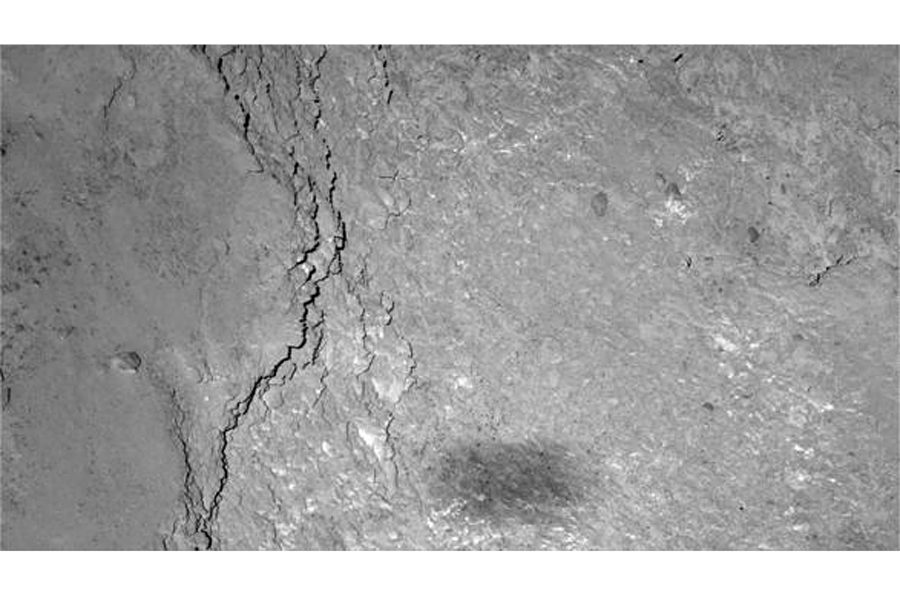Comet-orbiting spaceship glimpses its own shadow
Loading...
Sen—Europe's Rosetta space probe swooped so low over Comet 67P/Churyumov-Gerasimenko last month that it was able to photograph its own shadow, the European Space Agency (ESA) has revealed.
The spacecraft's high-resolution OSIRIS scientific imaging camera took the picture when Rosetta—which planted a lander, Philae, on Nov. 12, 2014—was only 6 km above the comet's surface. The image has now been radioed back to Earth.
The image shows the surface in greater detail than ever before, with the shadow a blur surrounded by a bright glow. With Rosetta so close, the 228-metre wide view shows detail with a resolution of just 11 cm to a pixel.
Rosetta project scientist, Dr Matt Taylor, told Sen: "Seeing the OSIRIS image with the shadow, for me was another fantastic juxtaposition of something made here on Earth and the wonderfully alien body we are becoming more familiar with at Comet 67P.
"We are still looking for Philae, but it was nice to find the shadow of Rosetta on the surface in the mean time. :) "
The zone that Rosetta flew low over is situated on the belly of the duck-shaped comet, which is steadily becoming more active as it heads in closer towards the Sun. In the full image, a pattern of steep slopes can be seen to separate a smooth landscape from rougher terrain.
Other images taken by the probe's wide-angle NAVCAM camera help to pinpoint the area on which the shadow fell.
While still looking for Philae, and analysing results from Rosetta's studies of the comet so far, the Rosetta team are also looking forward to the future as the probe gets to its innermost point in the Solar System, known as "perihelion".
Taylor told Sen: "I'm currently in a meeting of the Rosetta Science Working Team (SWT), going over what we have done, and what we are doing next in terms of mission and science operations.
"We have already started to learn things about 67P that will change our understanding of comets. Summer's perihelion pass is very much looked forward to!"
Comet 67P is not the first small Solar System body to catch the shadow of a spaceprobe. In November 2005, the Japanese space agency JAXA's Hayabusa craft snapped its own shadow on the surface of the asteroid Itokawa before it brushed itself into a landing.
It is immediately clear that Hayabusa's shadow is more distinct than the rather blurry one cast by Rosetta. ESA blogger Dr Emily Baldwin explains that this is due to the fact that the Sun would be shining as a disk in the sky, rather than a point of light.
This results in there being a "penumbra" around the main shadow, rather like that which the Earth casts on the Moon during a lunar eclipse.
Emily writes: "In this scenario and with Rosetta 6 km above the surface, the penumbra effect adds roughly 20 metres to the spacecraft's dimensions, and which is cast onto the tilted surface of the comet.
"If you were standing on the surface with Rosetta high above you, there would be no place in the shadow where the entire Sun would be blocked from view, which explains why there is no fully dark core to the shadow."
She adds: "Because Hayabusa was only a few tens of metres above the surface, the penumbral effect was much less, resulting in a sharper and darker shadow of the spacecraft."
The reason the dark comet looks brighter around the shadow is due to the illumination coming from directly behind the camera observing the scene, Emily explains. It is known as "opposition surge".
She writes: "Astronauts on the lunar surface saw the effect surrounding their own shadows. The primary cause of opposition surge is ‘shadow hiding'. When the Sun is directly behind the observer, the shadows cast by small grains disappear from the perspective of the observer, hidden behind the grains themselves, leading to a pronounced increase in brightness."
A similar effect can be seen on the Moon from Earth. A Full Moon is very much brighter than two half-Moons put together would be because the Sun's light is being reflected directly back towards the observer.
Related Links:
Blog: Cracking stuff as a comet gives up its secrets
Original story from Sen. © 2015 Sen TV Limited. All rights reserved. This material may not be published, broadcast, rewritten or redistributed. For more space news visit Sen.com and follow @sen on Twitter.







